We have two alilke HIS 7850 IceQ Turbo X
cards in our testing experiments. Being designed like the package of senior
products from HIS, this product’s package provides information about the
graphics card and the supported technologies.
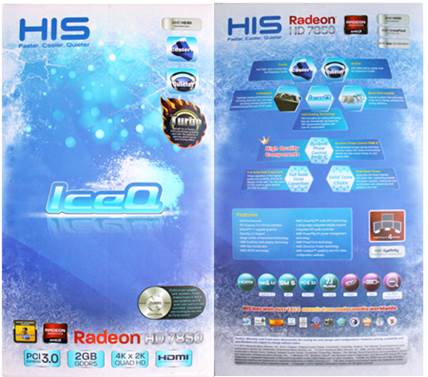
The
front/back box design
The box content is the same, except the
good graphics card. The price of HIS 7850 IceQ Turbo X is $ 200, more expensive
than other normal Radeon HD 7850 products, but HIS version has many advantages
which we will reveal now.
The original cooler covers PBC’s surface
and goes out its dimension even.

Covering
PBC’s surface
The card size is 297x140x44 mm. However, it
is thin in the middle area while the position of cooling fan is 50mm thicker.
Thus, HIS 7850 IceQ Turbo X can only be
used in CrossFireX configuration with the gap of at least two expansions from
other graphics cards. You should take this into account if you want to use it
in a CrossFireX tandem.
Like every other Radeon HD 7850, HIS 7850
IceQ Turbo X is equipped with a MIO connection to build up CrossFireX
configuration.
The producer has set up the power system
again, so the card is not only equipped one but two 6-pin power connections.
Its power consumption is regulated at 150W. One PSU 500W or better is
recommended for a computer with one HIS 7850 IceQ Turbo X inside.
If you have found some Radeon HD 7870 and
HD 7850, you can realize that HIS 7850 IceQ Turbo X uses the 5+1+1-phase power
of HD 7870 (GPU+ memory+ PLL) whereas the reference HD 7850 is one GPU power
phase fewer. It also has DrMOS MOSFET high-quality features with the upgraded
useful life.
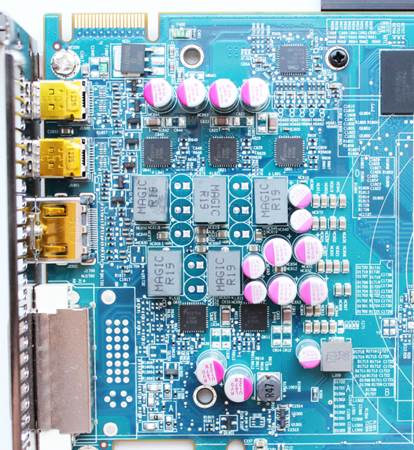
The
5+1+1 phase power system
The power system is managed by a CHiL
Semiconductor CHL8225G controller.
The Pitcairn XT chip is 212mm2
in size. It was produced in Taiwan in the 34th week of 2012.

The
Pitcairn XT chip
HIS 7850 IceQ Turbo X was pre-overclocked
at the GPU frequency of 1000MHz (+140MHz or 16.3%). According to our monitoring
tools, the GPU voltage was 1.075V and 0.806V respectively in 3D mode and 2D
mode. The clock rate also decreased to 300MHz in 2D applications.
The card is equipped with the
W2032BBBG-50-F memory chip which we have seen in HIS 7950 IceQ X² Boost Clock.
At the clock rate of 4800MHz, they provide
a bandwidth of 153.6 GB/s via a 256-bit bus.

The
bandwidth of 153.6 Gb/s via a 256-bit bus
Beside an integrated PCB and a
pre-overclocked CPU, HIS 7850 IceQ Turbo X features the original cooler HIS
IceQ.
It consists of a 115x94mm base, four
nickel-plated heat pipes which are soldered to aluminum fins (two central pipes
are 8mm in diameter and the other two are 6mm in diameter) and a plastic shell
with a radial fan.
The plastic shell is designed to let the
air go through the heatsink and then go out of the system case, cooling the
card’s circuitry
The orientating fan is 58mm in diameter. It
is evaluated to have the useful life up to 50000 hours. Its speed is PWM-regulated
in the range of 1000 and 3150 RPM.
The cooler deals well with the
pre-overclocked HIS 7850 IceQ Turbo X
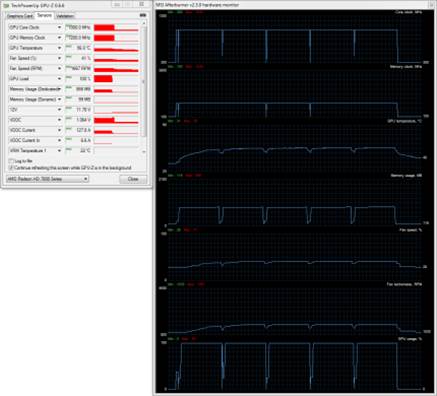
The
auto fan mode

The
maximum speed mode
When the fan automatically adjusts, its
speed reached 1670 while GPU was not hotter than 56°C. At the peak speed of
3150 RPM, the temperature was lower than 10°C. Replacing the default interface
with ARCTIC MX-4 helped us to decrease the thermal some degrees more in each
mode.

The
auto mode
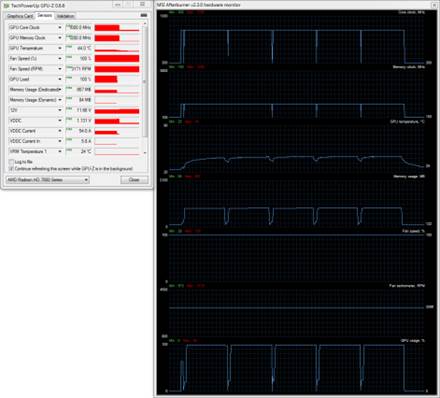
The
maximum speed mode
The HIS IceQ cooler is really impressive.
It just needs one more overclocked GPU. Thus, we guess this is the right time
to mention the HIS iTurbo exclusive features which are also very helpful for
overclocking, supervising and graphics cards managing.
We used 1.3.1 version, the newest that is
available on 19/11/2012. HIS iTurbo has four tabs in its main window. The info
tab provides information about graphics cards, including serial number. The
Overlook tab is where you can increase the GPU of the card and memory frequency
as well as Power Limit parameter and core voltage.
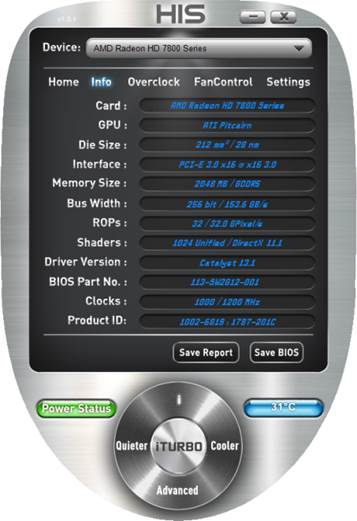
Info
tab

Overlook
tab
Moreover, you can also create four
overclocked files and quickly activate them anytime you want.
The Fan Control tab is for setting up the
fan speed and monitoring that speed as well as the temperature.

Fan
Control tab
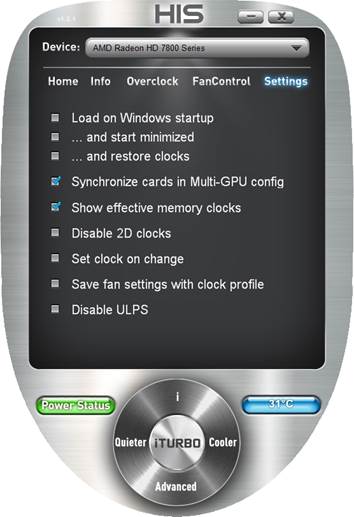
Setting
tab
The last tab of iTurbo provides selections
for the rest settings, including selection to activate the power-saving UPLS
mode (HIS recommends to do so if you overclock your card)
We tried to overclock two models of HIS
7850 IceQ Turbo X card using iTurbo and found out that they were the same in
the frequencies of memory. We managed to increase them up to 5750MHz. The GPUs
were stable at 1090 and1035MHz.
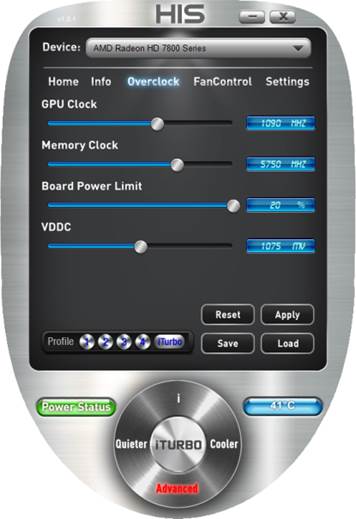
1090MHz

1035MHz
That does not mean too much overclocked,
especially when GPU clock rate of the first card can be reduced 20MHz to
prevent visual phenomenon.
The temperature of the card does not change
much when being overclocked.
|
Specifications
·
Graphic processor: “Pitcairn” (TSMC)
·
Production process: 28nm (low-k)
·
Mold size: 212mm2
·
Transistor: 2800mln
·
GPU frequency: 3D (1000MHz), 2D (300MHz)
·
GPU voltage: 1.075V (3D), 0.806V (2D)
·
Unified shader processor: 1024
·
Texturing unit: 80
·
Rasterization: 32 (ROPs)
·
The maximum theoretical filling rate: 32
(Gpixel/s)
·
Texture rate: 64 (Gtexel/s)
·
Pixel shader/ Peek shader: 5.0/5.0
·
Supportive memory type: GDDR5
·
Frequency of video memory: 4800MHz (3D),
600MHz (2D)
·
Memory capacity: 2048MB
·
Momery bus: 256 bit
·
Memory bandwidth: 153.6 GB/s
·
Maximum power consumption: 150W (3D), 20/3W
(2D)
·
PSU requirement: 500W
·
Reference PCB size (D x R x S): 297x140x44 mm
·
Interface: PCI- Express x16 (v3.0)
·
Output: 1DVI (Dual-link), 1 HDMI, 2
DisplayPort mini
·
Retail Price: $200
|